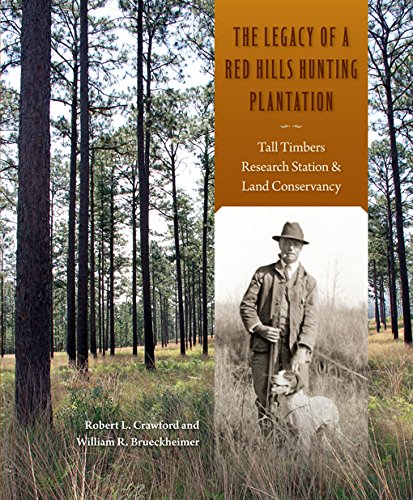Items related to The Legacy of a Red Hills Hunting Plantation: Tall...
The Legacy of a Red Hills Hunting Plantation: Tall Timbers Research Station & Land Conservancy - Hardcover

Synopsis
The Red Hills region is an idyllic setting filled with longleaf pine grasslands that stretches from Tallahassee, Florida, to Thomasville, Georgia. At its heart lies Tall Timbers, a former hunting plantation turned ecological research station.
In 1919, sportsman Henry L. Beadel purchased a plantation and renamed it Tall Timbers. As was the tradition, Beadel burned the woods after every hunting season in order to keep them clear of the thick brush required by ground foraging birds like quail. After the U.S. Forest Service condemned the practice in the 1920s as harmful for the forest and its wildlife, the quail population diminished dramatically.
Encouraged by his longtime friend Herbert L. Stoddard, who was conducting scientific bird research on his property, Beadel set his sights on conserving the land in order to study, among other things, the effects of fire on plants and wildlife. In 1958, Beadel, Stoddard, and others established Tall Timbers Research Station Inc. as a private, nonprofit corporation devoted to scientific purposes, and upon his death, Beadel donated his entire Tall Timbers estate to be used for ecological research in perpetuity.
This history of Tall Timbers is complemented by a wealth of unique and unpublished photographs that are in the site’s archival collections, including photographs from the late nineteenth century—many taken by Henry Beadel himself, who was both an accomplished and compulsive photographer. The book traces the transformation of the plantation into what its founders envisioned—a long-term plot study station, independent of government or academic control. It also reveals fascinating insights into the life of the wealthy landowner, Beadel, and his association with renowned naturalist Stoddard, which influenced his evolution from a sportsman to a naturalist and finally to a conservationist.
The original text was written between 1973 and 1984 by Tall Timbers Beadel Fellow William R. Brueckheimer as an outcome of his research on the Red Hills quail plantations and their land-use practices. The manuscript, which ended chronologically with the founding of Tall Timbers Research Station, languished in the station’s library for decades after completion. It passed through several hands until Robert Crawford was tasked with the assignment to edit, rewrite, and reorganize the original comprehensive, scholarly treatise and to bring the story up-to-date.
The result is a cultural and environmental history of the Red Hills region in general and the plantation community specifically. The volume spans thousands of years of human interaction with the land, from Indian prehistory through European settlement, the Gilded Age, the twentieth century, and ending in the present.
"synopsis" may belong to another edition of this title.
Book Description
Won the Silver Medal for Visual Arts in the Florida Book Awards, from the Florida State University Libraries.
The Red Hills region is an idyllic setting filled with longleaf pines that stretches from Tallahassee, Florida, to Thomasville, Georgia. At its heart lies Tall Timbers, a former hunting plantation.
In 1919, sportsman Henry L. Beadel purchased the Red Hills plantation to be used for quail hunting. As was the tradition, he conducted prescribed burnings after every hunting season in order to clear out the thick brush to make it more appealing to the nesting birds. After the U.S. Forest Service outlawed the practice in the 1920s, condemning it as harmful for the forest and its wildlife, the quail population diminished dramatically.
Astonished by this loss and encouraged by his naturalist friend Herbert L. Stoddard, Beadel set his sights on conserving the land in order to study the effects of prescribed burnings on wildlife. Upon his death in 1958, Beadel donated the entire Tall Timbers estate to be used as an ecological research station.
The Legacy of a Red Hills Hunting Plantation traces Beadel’s evolution from sportsman and naturalist to conservationist. Complemented by a wealth of previously unpublished, rare vintage photographs, it follows the transformation of the plantation into what its founders envisioned—a long-term plot study station, independent of government or academic funding and control.
From the Back Cover
“A fascinating history of the ecological consciousness and developing science of Florida’s Red Hills region.”—Sara Warner, author of Down to the Waterline
“No other work captures the range of scientific studies so vigorously pursued over the past century from quail biology to fire ecology to ecosystem management.”—Frederick R. Davis, author of The Man Who Saved Sea Turtles
"About this title" may belong to another edition of this title.
- PublisherUniversity Press of Florida
- Publication date2012
- ISBN 10 0813041481
- ISBN 13 9780813041483
- BindingHardcover
- LanguageEnglish
- Number of pages352
Shipping:
US$ 5.95
Within U.S.A.
Search results for The Legacy of a Red Hills Hunting Plantation: Tall...
The Legacy of a Red Hills Hunting Plantation: Tall Timbers Research Station & Land Conservancy
Seller: James Lasseter, Jr, Brooksville, FL, U.S.A.
Hardcover. Condition: Very Good Plus. Dust Jacket Condition: Fine. 1st Edition. Volume itself has a small red dot remainder mark on the top of the pages. Inside the back cover there is an approximate 3 inch by 2 inch white paper covering up something I am not sure what. This is an oversized and heavy 335 page work with an index all being printed on high quality paper. Number line in the book reads as follows: 17 16 15 14 13 12 6 5 4 3 2 1. Dust jacket is protected in an archival quality cover. Available for immediate shipment, carefully packed in a sturdy box! Seller Inventory # 014441
Quantity: 1 available
The Legacy of a Red Hills Hunting Plantation: Tall Timbers Research Station & Land Conservancy
Seller: Griffin Books, Stamford, CT, U.S.A.
hardcover. Condition: Like New. First Edition. First edition, first printing. Brand new gift quality hardcover in jacket oversized and overweight. Please email for photos. Larger books or sets may require additional shipping charges. Books sent via US Postal. Seller Inventory # 123104
Quantity: 1 available
